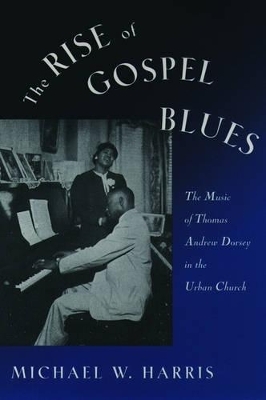
The Rise of Gospel Blues
The Music of Thomas Andrew Dorsey in the Urban Church
Seiten
1994
Oxford University Press Inc (Verlag)
978-0-19-509057-4 (ISBN)
Oxford University Press Inc (Verlag)
978-0-19-509057-4 (ISBN)
A well researched account of gospel blues that encompasses the broader cultural and religious histories of the African-American experience between the late 1890s and the 1930s. Harris skilfully contextualizes sacred and secular music styles within African-American religious history and significant social developments of the period.
Thomas A. Dorsey, also known as `Georgia Tom', had considerable success in the 1920's as a pianist, composer, and arranger for prominent blues singers including Ma Rainey. In the late 1930s, Dorsey became involved in African-American old-line Protestant churches, where his background in the blues greatly influenced his composing and singing. At first these `respectable' Chicago churches rejected this new form, partially because of the unseemly reputation blues performance had, but more because of the excitement that gospel blues produced in the church congregation. A controversy developed between two conflicting visions; one segment idealized an institution that nurtured a distinct African-American religion and culture, the other saw the church as a means by which African Americans would assimilate into American Christianity and the dominant Anglo-American culture. However, by the end of the 1930s the former group prevailed by the power of the music. From that time on, gospel blues became a major force in African-American churches and religion.
Thomas A. Dorsey, also known as `Georgia Tom', had considerable success in the 1920's as a pianist, composer, and arranger for prominent blues singers including Ma Rainey. In the late 1930s, Dorsey became involved in African-American old-line Protestant churches, where his background in the blues greatly influenced his composing and singing. At first these `respectable' Chicago churches rejected this new form, partially because of the unseemly reputation blues performance had, but more because of the excitement that gospel blues produced in the church congregation. A controversy developed between two conflicting visions; one segment idealized an institution that nurtured a distinct African-American religion and culture, the other saw the church as a means by which African Americans would assimilate into American Christianity and the dominant Anglo-American culture. However, by the end of the 1930s the former group prevailed by the power of the music. From that time on, gospel blues became a major force in African-American churches and religion.
Michael W. Harris is Associate Professor of History and African-American World Studies at the University of Iowa.
| Erscheint lt. Verlag | 21.7.1994 |
|---|---|
| Zusatzinfo | 6 pp halftones, music examples |
| Verlagsort | New York |
| Sprache | englisch |
| Maße | 140 x 216 mm |
| Gewicht | 445 g |
| Themenwelt | Kunst / Musik / Theater ► Musik ► Jazz / Blues |
| Geschichte ► Teilgebiete der Geschichte ► Kulturgeschichte | |
| Geisteswissenschaften ► Religion / Theologie ► Christentum | |
| Sozialwissenschaften ► Soziologie | |
| ISBN-10 | 0-19-509057-8 / 0195090578 |
| ISBN-13 | 978-0-19-509057-4 / 9780195090574 |
| Zustand | Neuware |
| Informationen gemäß Produktsicherheitsverordnung (GPSR) | |
| Haben Sie eine Frage zum Produkt? |
Mehr entdecken
aus dem Bereich
aus dem Bereich
Schulbuch Klassen 7/8 (G9)
Buch | Hardcover (2015)
Klett (Verlag)
31,50 €


